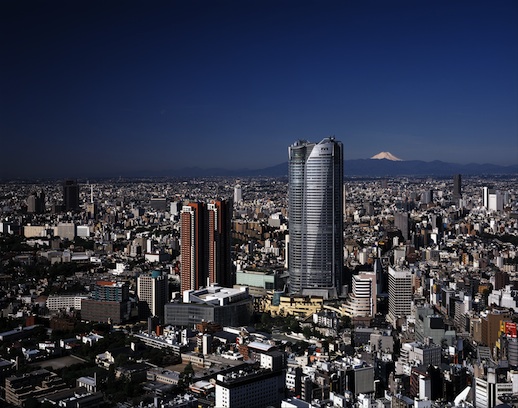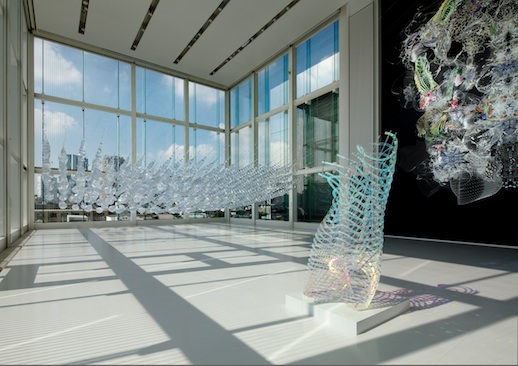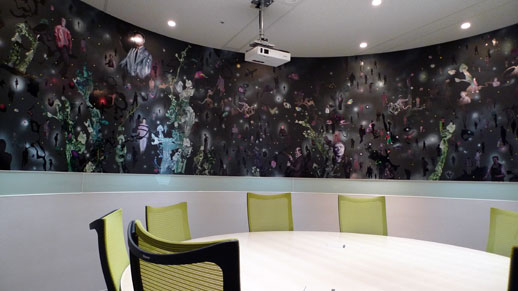Getting Down to Business
Snobs and socialists may wrinkle their noses but culture and big business can mix very amenably, as Japan has shown time and time again. It’s even been said that corporations, not public collections, own the best art in the country, especially of western art. Years before “CSR” became a buzzword for every company under the (rising) sun, Japanese businesses saw art as a major and stable investment, and a way to show off their success in the golden years of economic growth.
Nor are the corporations chary with their assets: Japan is full of museums showcasing the art owned by Bridgestone, Marubeni or Idemitsu. This first wave of corporate art collections feel mercantile: old-fashioned dynastic zaibatsu buying up wares and displaying them for the less successful world to see. Places like the Ohara Museum in Okayama prefecture, west Japan, or the Mitsubishi-Ichigokan Museum in central Tokyo feel like the private showrooms of rich and worldly entrepreneurs. The visitor is never sure if they should appreciate the exhibits, or the wealth.
Modern industry and boom years created plenty of liquid capital to spend on art. But this marriage of enterprise and art has not always been a satisfactory one. The vast spending spree in the late Eighties (estimated at $24 billion) became, post-Bubble, a virtual fire sale: corporations began selling off their collections and the national museums did not have the cash to grab the loot.
There were minor scandals in the early Nineties during the initial fallout, with two controversial, highly non-transparent sales by Mitsubishi and Sumitomo, allegedly involving inflated prices to conceal other payments. Another corporation even decided which auction house to use for a sale by a game of rock-paper-scissors: there was never any question of what might be best for the public good.

Post-Bubble Era
Shifts can be seen during the last few years, when business started building powerhouse art spaces, not for flaunting their private collections or building up assets, but to host international, contemporary exhibitions.
Real estate company Mori led the way with its eponymous major art museum in 2003 and fashion house Issey Miyake opened 21_21 Design Sight in 2007. Alongside the Shiseido and Maison Hermes galleries, these are far from places for merely promoting a brand name but respected sites with some of the best curating in the capital.
They have the backing and confidence to take new risks. Noriko Kamikawa, associate director of 21_21 Design Sight, says in Art Space Tokyo that the venue is “neither a design museum nor a design gallery… [We] wanted to create a place where many people could enjoy seeing, feeling, experiencing and learning about design.”
The results are palpable, both in visitor numbers and celebrity-studded opening nights, but also genuinely slick and strong curation from the organizers. The exhibitions at Mori are blockbusters in wholly different ways to the almanac shows that crop up constantly at major public museums, most typically a randomly assembled series of old paintings from a reputable European tourist site. It makes for rush hour level crowds and haberdashery attitudes towards the exhibits. Mori shows, on the other hand, feel planned and fresh almost every time.
Mori is also unusual in being open till late. This affects the visitor demographic; you tend to see a lot of people coming in after dinner or shopping. The fame of the Hills also brings in a lot of tourists, Asian and western, and since Mori often allows photography, it is not rare to see foreign visitors snapping holiday shots of themselves posed next to every exhibit in the show. The demographic might also explain why at least to this writer it appears that a very large proportion of visitors make use of the audio guides, and tour the exhibits with devices glued to ears. Unscientific surveys aside, these people are very different to the crowds who go to Tomio Koyama Gallery, or even to the latest bundle of goodies from the Louvre parachuted into an Ueno museum.
The choice of Roppongi by the Tokyo government’s funding bodies as a site for public art projects does seem curious, though. It’s one thing for Miyake, Mori et al to try to turn the once (or arguably still) dubious district into a safer, cleaner shopping town where relaxed consumers can browse international exhibitions. There is undoubted sincerity in the cause but it’s also all part of the wider promotion of the brands, or the push to increase the value of the land. In the opinion of this writer, they don’t need a helping hand and it seems a better choice in terms of urban renewal to hold events like the Smorgasbord that is the “Roppongi Art Night” in an area more like Bakurocho or Toshima. (Needless to say, this would also engender a name change for the “Art Night” at the same time.) After all, already plenty of projects are being developed there by cultural groups, so it’s just a matter of finding the right, appropriately large space.

Innovative Brands, Innovative Spaces
Shiseido in fact is one of the most interesting companies in Japan, period. The oldest cosmetics maker in the world, it has even dabbled in collaborative marketing with crossover Coca-Cola “aroma” beverages and body care products. Its museum first opened way back in 1919 and is said to be the oldest art gallery still operating in Japan, according to the venue’s publicity materials. (In fact, most of Japan’s first art galleries opened up originally inside department stores, thus arguably giving birth from the start to a local art culture fully embracing of the commercial and popular.) In 2001 Shiseido moved to its current location in Ginza, making a trip to the venerable district now very worthwhile, given the proximity of Hermes and other commercial galleries like Koyanagi, Tokyo Gallery + BTAP and Megumi Ogita.
Espace Louis Vuitton Tokyo, like Hermes, is another literally high-level glass space, this time on the seventh floor of the famous Jun Aoki building, magnificent in scale and funding. The venue opened in January 2011 as a model of the Paris Espace. A new kid on the block, then, but judging from its exhibitions of visiting overseas artists so far (Xavier Veilhan, and currently Alyson Shotz), the team behind it have ambitions. The only hurdle now is to get the message across to people passing on Omotesando that LV is not just about selling luxury items.
Less trendy but no less wealthy, Sony also runs its annual Canvas Art Wall competition to decorate the exterior of its Ginza showroom space. The resulting works tends to be safe — big, bright and cheerful stuff — but the commitment is admirable to reward potentially unknown artists with mass exposure.
Family Fun
The Hara Museum of Contemporary Art matches Mori for curation resources and international recognition, though the venue and the family scion behind it feel more like old money than the flashy urban wealth of the Roppongi.
The pre-war residence near Shinagawa was converted into an art museum in 1979, and hosts a hive of permanent installations alongside its revolving international exhibits. No visit to the Hara is complete without fully exploring the nooks and crannies, particularly upstairs, housing work by Tatsuo Miyajima, Yoshihiro Suda and more, as well as that rare treasure in Tokyo, an elegant garden. White cube galleries, eat your hearts out.
Another family very much doing their own thing is the Watari dynasty, with its popular Watari-um space, a central part of the Gaienmae community and likewise full of unusual exhibition dimensions a far cry from the typical Tokyo gallery.
A Foot in the Door
Another innovative recent example of this new chapter in corporate-art symbiosis is the Art In The Office scheme, run by the non-profit organization Arts Initiative Tokyo in co-operation with Monex Group Inc.

An annual competition since 2008, it involves a yearlong installation of one main work in a meeting room inside the Monex’s central Tokyo headquarters. The space is not open to the general public; rather, the project aims to bring art right into a corporate environment: finance workers who do not normally encounter contemporary art can experience a whole new professional context while they do their jobs.
“The artist works in the office installing the final piece for around two weeks,” explains Yuko Shiomi of A.I.T. “What is important for the project is that this is not just a commission or ‘collaboration’, but that the artist comes into the office and interested employees can interact with him or her.”
Media covering the finance sector thus inadvertently offer up glimpses of contemporary art to readers and viewers. The winning entry physically adorns not only the office space but also the cover of Monex’s annual report, so customers and shareholders are introduced by osmosis to a world less dry than the statistics of currencies and commodities.
Post-3.11
There is much to get excited and laudatory about with regards to Japanese business. In a country without a real tradition of government subsidy in the arts, it is the corporations who are often the leaders and sponsors. However, not every development is worthy of applause and caution is circumspect when greeting yet another art space built by a “generous” corporation. No one would accuse Suntory of being particularly innovative with their art spaces around Japan and certainly too much corporate enthusiasm can lead to over-drive, or even kitsch (case in point, Benesse’s takemake-over of Naoshima). The most extreme example may well be the Miho Museum in Shiga prefecture, a beautifully designed facility in the mountains and created by IM Pei, housing a priceless collection of antiquities. Little known by Japanese, it is more famous abroad but upon arrival feels bizarrely like the headquarters of a cult (it is in fact funded by a religious organization) or like a set designer practising for the next James Bond extravaganza.
It is surely now the duty for business to help in a subtle and non-controlling way in the regeneration of east Tokyo. Certainly amongst the re-building of Tohoku too there will be opportunities to create community art projects and corporations can make a difference here. But we must hope they take a hands-off approach, providing funds for curators and commissions, but not stamping logos and shaping press releases.
Perhaps then the artists themselves can truly get down to business.
Brief Chronology
1952: The Bridgestone Museum of Art opens
1979: The Hara family converts its residence into the Hara Museum of Contemporary Art
1990: Watari Museum of Contemporary Art opens
2001: Shiseido Gallery moves to the Tokyo Ginza Shiseido Building
2003: The Mori Art Museum opens
2007: 21_21 Design Sight opens
2011: Espace Louis Vuitton Tokyo opens
William Andrews
William Andrews



